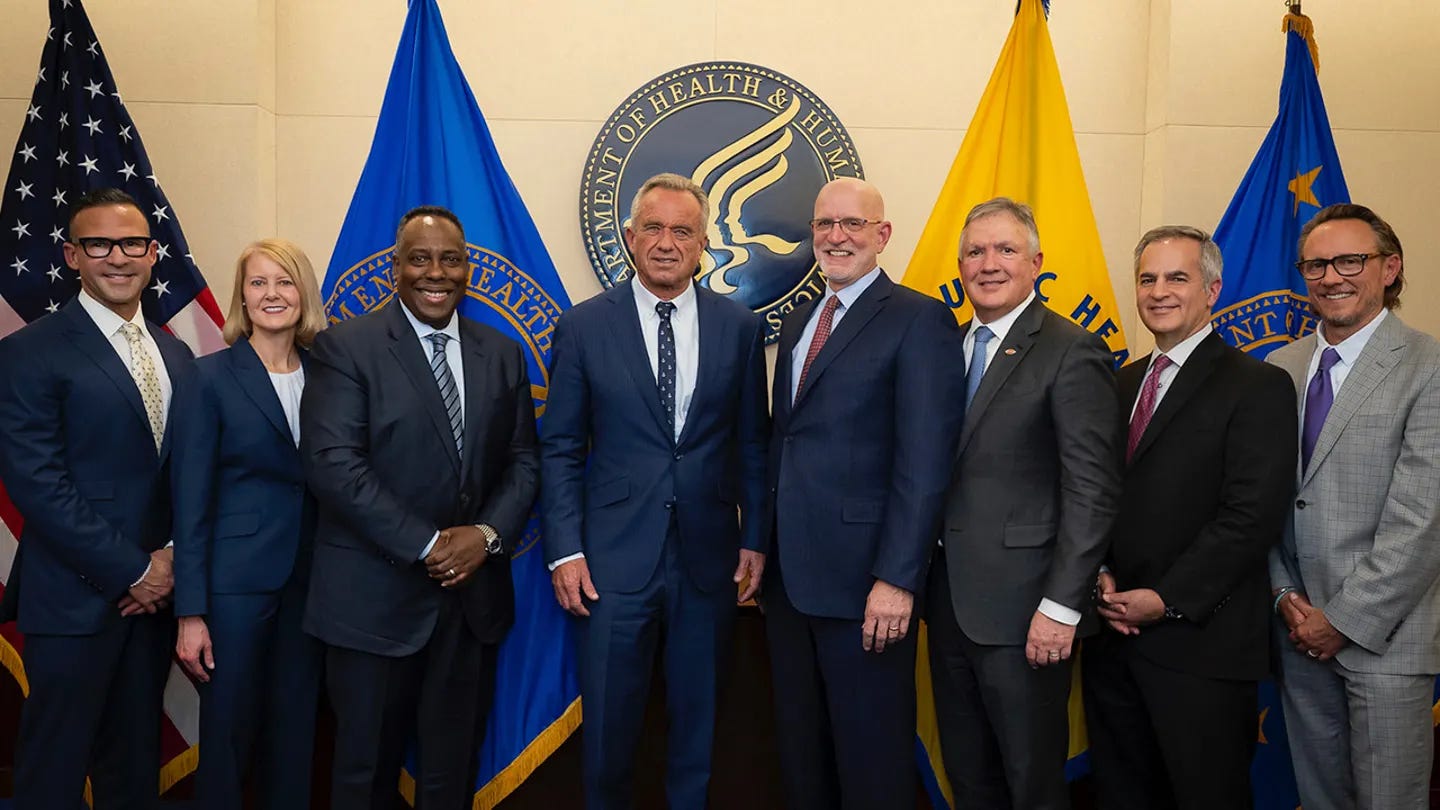Breaking: White House Releases Bold MAHA Strategy Report on Ending America’s Childhood Chronic Disease Epidemic
Report encourages community and private sector collaboration with government
By Adam Garrie, Breaking News Reporter, and Staff, The MAHA Report
On Tuesday afternoon, the MAHA Commission to President Trump, established by the president in February via Executive Order 14212 and chaired by Secretary of Health and Human Services Robert F. Kennedy Jr., released “Strategy Report: Make Our Children Healthy Again.”
The new report, 19-pages long, which includes 128 targeted strategies, supersedes the assessment released by the commission in May and a ‘leaked’ draft discussed in the media in August.
The report covers a wide range of health, environmental, and pharmaceutical issues that Kennedy and colleagues at the HHS have already begun to address. But it goes further, addressing areas never given significant federal attention such as conflicts of interest by federal employees, vaccine injuries, cumulative exposure to toxins (agricultural chemicals and chemicals in food), the mental health crisis exacerbated by over-medicating our children, and the root causes of diseases.
Moreover, it outlines specific actions the government plans to take – to end the crisis of chronic disease among America’s children – while it also enumerates initiatives that invite private sector and community-based collaboration with the government.
“This report is an incredible success story,” said Tony Lyons, President, MAHA Action. “HHS has gotten more done than any public health agency in history. The report shows a laundry list of more than a hundred major wins from the various agencies. These new programs, new directions, new research projects, laws, executive orders, and initiatives to make America healthy again are nothing short of epic. God bless President Trump for putting Secretary Kennedy in a position where he can end the chronic disease epidemic and make all Americans healthier.”
Page two of the report identifies four pillars through which the commission plans to fulfill its goal to “End Childhood Chronic Disease”: Advance Research, Realign Incentives, Foster Private Sector Collaboration, and Increase Public Awareness.
The following are some of the key areas covered in the MAHA Commission’s report:
Vaccines
The HHS and NIH will jointly research vaccine injuries through a new vaccine injury research program at the NIH Clinical Center. In addition to ongoing research on potential vaccine harms, the report pledges to create a culture of transparency and gold standard science underlying all vaccine development and recommendations.
The report also pledges to develop a world leading childhood vaccine schedule. Two additional priorities on vaccines include, “Correcting conflicts of interest and misaligned incentives; and…Ensuring scientific and medical freedom.” These represent a major break with past priorities when medical freedom was never promoted by federal health agencies.
Farming
The USDA and EPA (two agencies not directly under the auspices of HHS) will collaborate to help farmers develop high yield, cost effective farming methods that reduce reliance on traditional pesticides.
The report stresses a farmer-first approach that refuses to rely on “mandates.” Central to the private-public partnerships between federal agencies and farmers will be projects that emphasize soil health.
The report states that the USDA will begin to streamline the process of organic certification while helping farmers who wish to transition to organic farming.
Federal agencies will work collaboratively to increase food access and choice by removing restrictions on whole milk sales in schools, eliminating mandatory reduced-fat requirements in federal nutrition programs, and easing barriers for small dairy operations to process and sell milk locally.
Additionally, zoning restrictions on mobile grocery units in so-called ‘food deserts’ will be lifted; permits for grocery stores in underserved areas will be fast-tracked; and sustainable incentive programs will be developed with grocers to provide a variety of fruits and vegetables.
Nutrition
According to the report, the NIH, FDA, USDA, and AHA will collaborate on high-quality nutrition research and ingredient assessments.
The NIH will expand dietary pattern research for metabolic health, utilize the new FDA-NIH Joint Nutrition Regulatory Science Program, and USDA will prioritize precision nutrition research.
The report also states that, “HHS will add questions to the National Survey of Children’s Health that focus on nutrition.”
The NIH and CDC will further collaborate on tracing links between poor oral health in children and the onset of chronic disease.
The FDA will continue its ongoing work to phase out petroleum-based food dyes while the “USDA will apply the framework to food served through Federal nutrition programs, especially the school lunch program.”
The FDA will enhance its evidence-based systematic process for post-market assessment of chemicals in food, including additives, GRAS substances, food contact materials, and environmental contaminants.
The report adds that the NIH “will continue to fund research to deepen our understanding of the gut microbiome’s critical role in chronic disease development and progression in children to identify novel interventions that could transform preventive and therapeutic approaches.”
The FDA is considering changes to food labeling regulations to help provide more detailed, accurate, and clear nutritional information to consumers.
The USDA pledged further support to states seeking to remove junk food acquisitions from the SNAP program. The USDA will further develop “MAHA boxes” containing healthy foods for SNAP recipients.
Finally, “USDA, HHS, and FDA will continue efforts to develop a U.S. government-wide definition for ‘‘Ultra-processed Food’ to support potential future research and policy activity.”
Water
The EPA, USDA and relevant federal health agencies will work to ensure greater water quality with a specific focus on researching the risks of fluoride in drinking water.
The CDC will be informed of the findings of research into the dangers to human health of fluoridated water. The CDC will also be ordered to examine the health risks associated with PFAS (aka forever chemicals) in the water table.
The report further states, “Agency research could also include research to inform the understanding of levels of pharmaceuticals in our water supply that could be adversely affecting animal and human health.”
Fitness
Fitness is presented as a major component of the fight against childhood chronic disease. According to the report, “HHS and the Department of Education (ED) will partner with the President’s Council on Sports, Fitness, and Nutrition (PCSFN) to help states and schools re-establish the Presidential Fitness Test.”
The Administration for Children and Families (ACF) will partner with PCSFN to promote physical activity for children outside of schools.
Drugs & Medication
One of the main four pillars of the report is overmedicalization. Health agencies will encourage steps to move the nation away from a culture of excessive prescription.
The FDA will continue work to end animal testing requirements for clinical trials.
Multiple agencies, including the FDA, will expand New Approach Methodologies (NAMs) to improve diagnostic accuracy.
The FDA will further “Facilitate the use of regenerative medicine innovation by modernizing policies as clinical data is established,” according to the report.
The FDA and NIH will partner to investigate the potential of repurposing drugs to fight chronic disease.
Agency Reform
As part of the wider fight against conflicts of interest and corporate capture, Secretary Kennedy will direct the FDA, CDC, and NIH to review participation in any projects or initiatives funded by food and pharmaceutical companies through the CDC Foundation, Foundation for the NIH, or the Reagan-Udall Foundation.
The HHS will undergo a major reorganization to establish the Administration for a Healthy America (AHA), a new agency focused on coordinating the federal response to the chronic disease crisis through integrated, prevention-oriented programs and streamlined accountability.
The HHS, in collaboration with the White House Domestic Policy Council, will reassess the Forum on Child and Family Statistics to re-prioritize its focus on childhood chronic disease.
Medical Health & Addiction
The report promises further research and actionable solutions to the links between chemical exposure, lack of physical fitness, and ultra-processed foods and deteriorating mental health in children.
The HHS and other relevant agencies – including but not limited to the FDA, CMS, and NIH – will convene a working group to examine prescription patterns of mental health medications for children.
This group will review diagnostic thresholds, identify trends in overprescription, and explore potential links between medicines prescribed to children and cognitive and mental health problems.
The NIH and HHS will strengthen a partnership to research the effects of addiction on overall mental health.
Autism
The HHS and CDC will continue to study environmental and other causes of the autism epidemic. A full report on the exponentially growing rates of autism will be released by HHS. This report is expected in September, 2025.
Chronic Disease
Central to each subsection of the report is an emphasis on rolling back and ultimately ending the chronic disease epidemic. The NIH will launch a new chronic disease initiative that will research the causes of, and develop solutions to, growing rates of childhood and adult chronic disease.
Additionally, “The NIH will launch a new Whole-Person-Health approach to chronic disease prevention research and leverage collective expertise across the agency to catalyze transformative discovery science and intervention strategies that promote wellness, resilience, and optimal health, including metabolic health, at all stages of life.”
Chemical Exposure
The report concludes that many childhood chronic diseases are caused by exposure to dangerous chemicals. According to the report, “The current regulatory framework should be continually evaluated to ensure that chemicals and other exposures do not interact together to pose a threat to the health of our children.”
The EPA, USDA, and NIH will create a framework to study cumulative chemical exposure, emphasizing new approach methodologies (NAMs) and computational tools, while EPA will enhance NAM based methods for assessing pesticide risks under federal regulations.











A good enough start creating agencies to fix problems, but nothing new that we did not already know! Just want the vaccine investigation, injuries and so many (72) for children to be accounted for! No tiny human from birth should be riddled with so many chemicals! God gave us a beautiful and robust immune system that is being destroyed by chemicals funding big pharma and doctors! 😡
Thx for the list!! And all you do. Brings tears of joy to my eyes. Finally, things may change for the better. 👍🏼🤞🏽🙏🏽